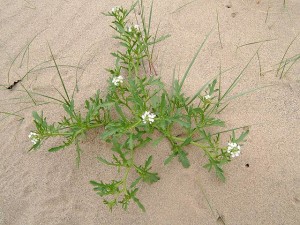Written by Ashley Parrish-Decker
Recently I’ve been interested in the principles of permaculture, but in permaculture they say there is no such thing as an invasive plants or weeds, but rather that all things in a given eco-system can be beneficial.
I was curious what a wildlife restoration biologist might say about this debate of invasives vs natives so I asked Dave Hubbard of Coastal Restoration Consultants Inc. his thoughts on the matter. He told me that native plants are the true bio engineers of their land and we need them to thrive in order to protect our coastlines. They know the land better than anything. They are huge supporters of the local birds, insects and even other native plants. It was fascinating talking to him about the importance of these Dune restoration projects not just from a stand point of the value for plants, and the animals that call these places home but even the benefits they have for human developement.
He said he had recently gone to New Jersey, where there are dune areas so protected that if you so much as step on them it’s an automatic $1,000 fine. The amazing thing is, that during hurricane Sandy, houses that were behind these dune protected areas were left undamaged during and after the storm, whereas those houses in areas where sand is moved around and there is no vegetation to protect them were completely destroyed. With issues like sea level rise and big storms, having dune ecosystems with the deep root systems of native plants, we can prevent a lot of future damage in our costal cities. In the case of Surfers’ Point part of the goal was to prevent further erosion to an already crumbling bike path, but it will also protect the structures in place directly behind the dune areas.
“We had a really nice day at Surfer’s Point on Saturday. Excellent Surfrider logistics. Great volunteers. Lots of education and outreach time mixed in. We mopped 99.9% of the remaining sea rocket across the entire dune restoration site, also weeded tumbleweed, iceplant, non-native chrysanthemum, some grasses and misc. weeds. The timing worked out really well. The sea rocket seeds were not ripe yet, so we got them before they dropped.”
If you are not familiar with Sea Rocket this picture here shows you who our main target was that day. Sea Rocket likes to grow in the native Beach Burr. It is very clever little sucker in that it has made it self look almost exactly like the native Beach Burr with the exception that is has a 4 petaled lavender flower and is more green then the Beach Burr, which has a yellow flower when it blooms.
Overall, the workday was a great success and something Surfrider will continue to monitor and take care of for years to come along with the City of Ventura.
As Dave said, luckily there are not too many plants that can survive in salty, nutrient-poor, well-drained, beach sand but our beaches are not the only places where plants from out of town don’t belong. To learn more about Invasive Plants you can go to the Cal IPC Website to find out definitions of an invasive as well as impact. This and other websites like Plant Right also provide you with lists and pictures of plants that are considered invasive and why.
It’s time we really start working with Nature and really think about the impact we are having. You know how they say when camping or backpacking or even hiking that the ethical thing to do is to leave no trace? Pack it in, pack it out? That’s a practice I think we should have in our everyday lives and especially when we are thinking of our landscapes.


